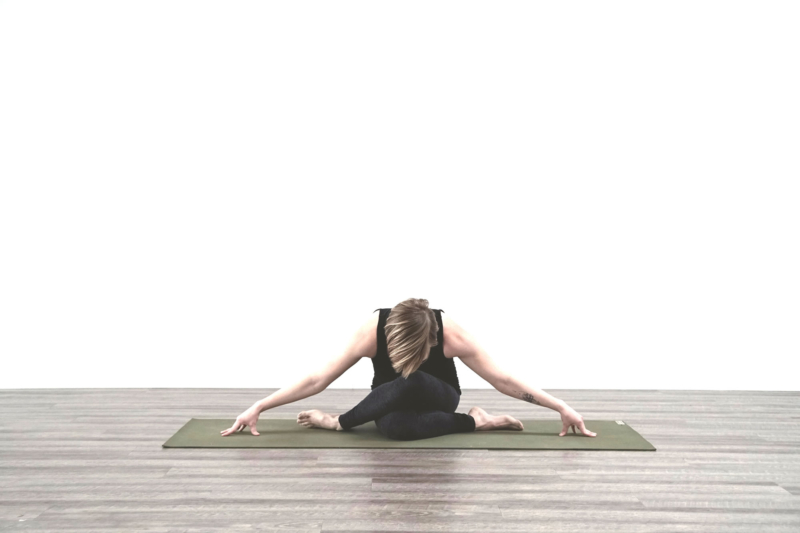[et_pb_section fb_built=”1″ _builder_version=”3.22″][et_pb_row _builder_version=”3.25″][et_pb_column type=”4_4″ _builder_version=”3.25″ custom_padding=”|||” custom_padding__hover=”|||”][et_pb_text _builder_version=”3.27.4″]Pause. Close your eyes. Take a breath. Reflect for a moment. What brought you to your mat the first time you stepped on it? What keeps you practicing yoga now?
For many, it was a goal to be physically healthy and move our bodies more. Perhaps it was the pursuit of mental well being or stress relief. Maybe it was cross training for another athletic activity or simply the desire to try something new. Reflecting on your yoga origin story can be a good way to pay homage to your journey and connect back to your original intentions. But what keeps you coming back might be something entirely different than what drew you on day one. For most of us, diving deeper into the physical practice of yoga has become an invitation to do the work of a lifetime – the work of understanding ourselves, liberating our minds from a limited consciousness, and moving with more strength and ease.
I believe these questions are worth considering and reconsidering. One of the most important things I took from the first module of my 300-hour advanced yoga teacher training with Jason Crandell earlier this year is the call to think critically as a yoga teacher and practitioner. To consider why we practice yoga and whether the ways we show up on our mat is consistent with this intention or objective. Or, as teachers, whether the way we are sequencing and showing up for our students aligns with what’s important to us.
These questions and this invitation to think critically have driven me to continue to evolve in my teaching over the last three years and continue to ask why. Why do we cue a certain position of the hips in Warrior 1 instead of another? Why do we move at the pace that we do and does it align with our priories in our practice? What fuels and informs our sequences? Are we willing to reconsider the yogic “dogma” we were taught while still respecting its role in our journey? When do we feel like our truest selves and when do we encounter ego taking the lead, both on and off the mat?
Each time we come to our mats, we have choices. As a yoga teacher, I have choices.
As a teacher of public classes, I cannot begin to predict what each student needs in their practice, in body or mind, and attempting to do so would be futile and crazy-making. As such, I seek to empower my students to pay attention to their bodies, energetic needs, and mental activity, over time and each day, in order to make the choices that are best for them. I ask that they get comfortable with the answer “It depends” and recognize the beautiful landscape of variations available to them in this lifelong practice.
As a teacher, I can gain clarity on my intentions and continue to sharpen the tools in my toolbox. This is how Strong and Sustainable came to be.
My intention as a teacher is to help my students cultivate strong bodies and bold hearts. As an asana teacher, this means being willing to consider strength and range of motion as an intertwined objective, rather than glorifying flexibility that isn’t reasonable for most bodies. I aim to help my students move from a place of stability by creating sequences that are balanced over time and have a place within a broader curriculum. I will teach from an organized framework informed by an understanding of how people learn. I will focus on strengthening the muscles we often stretch in vinyasa yoga and opening regions of the modern body that are often restricted. I will consider the “why” behind the choices that I make in creating this curriculum and encourage my students to do the same. Through these efforts, we will work as teachers and students to see ourselves clearly, recognizing our limiting beliefs and seeking to respond to ourselves and each other with grace.
I also want to help my students forge a practice that is sustainable over time. We seek to move and breathe and feel more at home in our bodies. We hope to be able to tie our shoes at 80. I want my students to be able to continue this life’s work on their mats 30 years from now. With these intentions in mind, I will continue to promote diversity of movement patterns, knowing that tissue responds well to a variety of stresses and demands. I will dare to step outside the traditional “dogma” and take a critical look at yoga techniques; I will remain willing to update my approach when my body of knowledge expands and indicates a change. I will aim to empower my students to keep an open mind and allow their practice to ebb and flow in accordance with their evolving needs and experience. I will invite them to appreciate that growing in their practice is not limited to postural prowess but also skillfully responding to their needs and expanded powers of attention and compassion. I will strive to create a safe and inclusive space where students are empowered to work with and honor each step of their journey.
May your body be strong, your heart bold, your mind expansive. May your practice sustain you in these dynamic pursuits. These are my intentions. I would love to hear more about yours.
May the work we do together inspire the highest good in one another and allow them to manifest.
-Caitlin Goodin
If you are interested in learning more about Strong and Sustainable! Come to Caitlin’s workshop on June 8th! You can sign up at tuladharayoga.com/events
[/et_pb_text][/et_pb_column][/et_pb_row][/et_pb_section]





